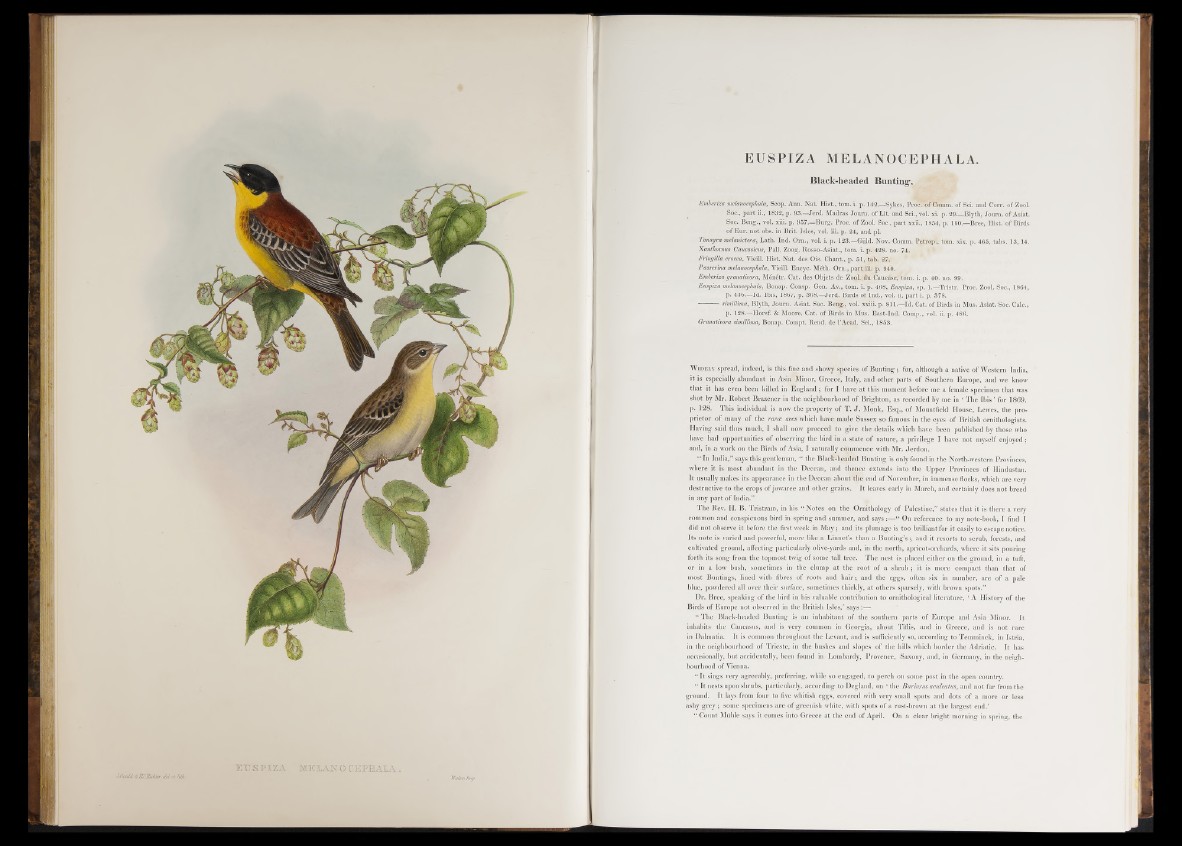
ETT S F IZ A ME.XAN'O CEPHALA
J.Gotdd/ follGBilhta'. ¿lél- el Wv. Walla, Imp.
EUSPIZA MELANOCEPHALA.
Black-headed Bunting“.
Ember iza melanocephala, Scop. Ann. N a t. Hist., tom. i. p. 142.—Sykes, E rS lte ft& m m . ofS c i. and Corr. of Zool.
Soc., p a r t ii., 1832, p. 93.—Jerd . Madras Journ. of Lit. and Sci., vol. xi. p. 29.—Blyth, Journ. o f Asiat.
Soc. Beng., vol. xiii. p. 957— Burg. Proc. o f Zool. Soc., p a rt xxii., 1854, p. 160.— Bree, Hist, of Birds
o f E ur. n o t obs. in Brit. Isles, vol. in. p. 24, and pi.
Tanagra melanictera, Lath. Ind. O ra ., vol. i. p. 123.—Giild. Nov. Comm. Petropi, tom. xix. p. 465, tabs. 13,14.
Xanthomus Caucasicus, Pall. Zoog. Rosso-Asiat., tom. i. p. 428. no. 74.
Fringilla crocea, Vieill. Hist, Na t. des Ois. Chant., p . 51, tab. 27.
Passerina melanocephala, Vieill. Encyc. Meth. Orn., part/iiii p . 940.
Emberiza granativora, Memetr. Cat. des Objets de Zool. du Caucasef tom. i. p. 40. no, 99.
Euspiza melanocephala, Bonap. Consp. Gen. Av., tom. i. p. 468, Euspiza, sp. 1.—T ristr. Proc. Zool. Soc., 1864,
p. 446— Id . Ibis, 1867, p. 368.—Jerd . Birds of In d ., vol. ii. p a rt i. p. 378.
simillima, Blyth, Journ. Asiat. Soc. Beng., vol. xxiii. p. 811.—Id . Cat. of Birds in Mus. Asiat. Soc. Calc.,
p. 128.—Horsf. & Moore, Cat. o f B irds in Mus. East-Ind. Comp., vol. ii. p. 486.
Granativora simillima, Bonap. Compt. Rend. de l ’Acad. Sci., 1853.
W i d e l y spread, indeed, is this fine and showy species of Bunting; for, although a native of Western India,
it is especially abundant in Asia Minor, Greece, Italy, and other parts o f Southern Europe, and we know
that it has even been killed in England ; for I have at this moment before me a female specimen that was
shot by Mr. Robert Brazener in the neighbourhood of Brighton, as recorded by me in ‘ The Ib is’ for 1869,
p. 128. This individual is now the property of T. J . Monk, Esq., o f Mountfield House, Lewes, the proprietor
of many of the rarce aves which have made Sussex so famous in the eyes o f British ornithologists.
Having said thus much, I shall now proceed to give the details which have been published by those who
have had opportunities of observing the bird in a state of nature, a privilege I have not myself enjoyed;
and, in a work on the Birds of Asia, I naturally commence with Mr. Jerdon.
“ In India,” says this gentleman, “ the Blac&headed Bunting is only found in the North-western Provinces,
where it is most abundant in the Deccan, and thence extends into the Upper Provinces of Hindustan.
It usually makes its appearance in the Deccan about the end o f November, in immense flocks, which are very
destructive to the crops o f jowaree and other grains. It leaves early in March, and certainly does not breed
in any part o f India.”
The Rev. H. B. Tristram, in his “ Notes on the Ornithology of Palestine,” states that it is there a very
common and conspicuous bird in spring and summer, and says:— “ On reference to my note-book, I find I
did not observe it before the first week in May; and its plumage is too brilliant for it easily to escape notice.
Its note is varied and powerful, more like a Linnet’s than a Bunting’s ; and it resorts to scrub, forests, and
cultivated ground, affecting particularly olive-yards and, in the north, apricot-orchards, where it sits pouring
forth its song from the topmost twig of some tall tree. The nest is placed either on the ground, in a tuft,
or in a low bush, sometimes in the clump a t the root of a s h ru b ; it is more compact than that of
most Buntings, lined with fibres o f roots and ha ir; and the eggs, often six in number, are o f a pale
blue, powdered all over their surface, sometimes thickly, a t others sparsely, with brown spots.”
Dr. Bree, speaking of the bird in his valuable contribution to ornithological literature, ‘ A History of the
Birds of Europe not observed in the British Isles,’ says :—
“ The Black-headed Bunting is an inhabitant of the southern parts of Europe and Asia Minor. It
inhabits the Caucasus, and is very common in Georgia, about Tiflis, and in Greece, and is not rare
in Dalmatia. It is common throughout the Levant, and is sufficiently so, according to Temminck, in Istria,
in the neighbourhood of Trieste, in the bushes and slopes of the hills which border the Adriatic. It has
occasionally, but accidentally, been found in Lombardy, Provence, Saxony, and, in Germany, in the neighbourhood
of Vienna.
“ I t sings very agreeably, preferring, while so engaged, to perch on some post in the open country.
“ It nests upon shrubs, particularly, according to Degland, on ‘ the Bariums aculeatm, and not far from the
ground. I t lays from four to five whitish eggs, covered with very small spots and dots of a more or less
ashy g r e y ; some specimens are o f greenish white, with spots of a rust-brown at the largest end.’
“ Count Miihle says it comes into Greece at the end o f April. On a clear bright morning in spring, the